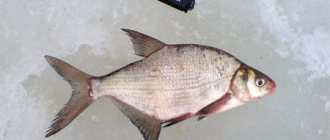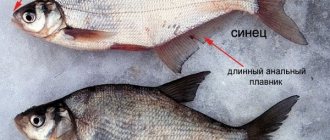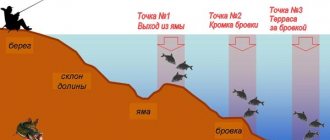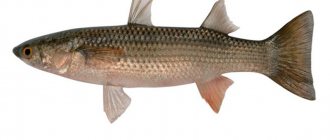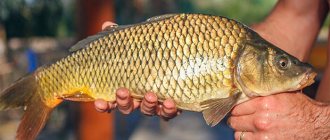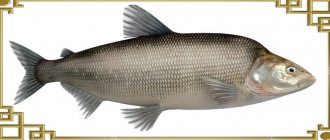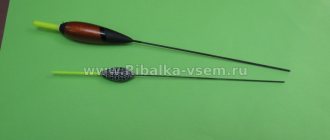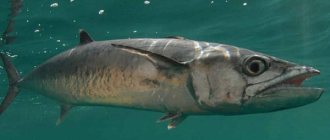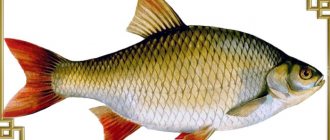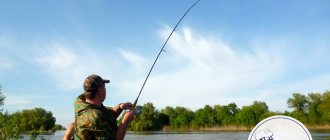Promising places
This representative of cyprinids is found both in still waters and on large rivers. For trophy options of a decent size, you should go to reservoirs that are not small; bream from 3 kg or more are home to:
- large lakes;
- decent sized reservoirs;
- large rivers.
The flock will settle on the shallows only at the very beginning of spring, when the sun is just beginning to warm up the water. With an increase in air and water temperatures, the fish will move to decent depths and will stand there, coming out to feed mainly at night.
Favorite parking places are holes of 4 m or more, and large individuals are almost always found at the greatest depths of the reservoir.
The most promising places are considered to be holes located at a distance of 40-50 m from the coastline. There you can fish with different types of gear with or without a watercraft.
Beginner fishermen should also pay attention to:
- at the reeds;
- places with little underwater vegetation.
There, the carp representative feels protected, becomes less timid, and gladly takes almost all the goodies offered on the hook.
How to choose bait for bream
Spring bait
To fish in reservoirs with a current, it is necessary to add viscosity ; for this, clay from the reservoir and pea flour are used. Fraction : small, but always with the addition of large pieces of live maggots and food bloodworms. Color : light Smell : coriander is the best option Additives to attract large fish: instant corn, crushed peas, scalded maggot
Summer baits
In the summer heat, many complain about a complete lack of bite , but this is not always true. Properly selected bait can attract the attention of bream even in the heat. June: worm, maggot, corn, peas, pasta. July: steamed barley, maggot worms in the form of sandwiches. August: bread, pasta, corn, maggot worm. Temporary decreases in temperature indicators will entail a return of bream to animal types of bait ; vegetable bait should be offered in hot weather.
Autumn lures
In the autumn, bream continue to be actively caught on the feeder; groundbait and bait, as before, should work in tandem in such gear. As the temperature drops, bream will again want “meat” baits. September: earthworm and dung worm, maggot, hominy, bread, steamed cereals. October: bloodworms, worms, less often maggots. November: maggots and bloodworms, plant-based baits will not work. It is important to understand that the bait used in crushed form must be added to the bait.
Winter lures
In winter, bait for bream is very important; it is more difficult for passive fish to attract attention . Therefore, the selection of bait should be approached very carefully. December: sandwiches made from pieces of worms, bloodworms and maggots, less often boiled peas are used. January: bloodworm, worm. February: worm, bloodworm, semolina, peas. You can experiment and try using the dough as bait; at the end of February, bream can respond well to this species.
Distinctive features
The first and main difference is the size of the fish. White bream up to 1 kg, bream more. Appearance: flat silver bream and well-fed golden bream, with a characteristic hump near the head. Differences in character and behavior, therefore different fishing tactics, gear used, lures, bait and their quantity.
The bream is an adult, the white bream is a small fish or a juvenile. Favorite habitats are different: it is difficult for a bream to cope with a strong current, and a bream can even stand in the fairway.
The amount of mucus around the fish: the bream has more, the bream has a little. An adult specimen is a commercial fish in Russia. Only bream reproduces. Miscellaneous tasks:
- small fish strive to grow as quickly as possible, so they move a lot in order to search for food; large fish gain fat, are not highly mobile and can spend a lot of time standing in one place grinding shell rock or looking for more high-calorie food in a layer of silt.
Adult fish stay in the depths during the day, actively feed at night and approach the shoreline in search of living creatures raised from the bottom by the surf. The bream almost does not feed at night and retreats to the depths. Different taste qualities:
- the bony bream is dried and dried;
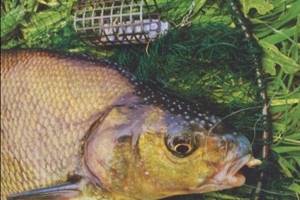
- Fatty, well-fed and juicy bream, a welcome guest on the table of any chef, prepares various dishes and delicacies from it.
We hope that the material was interesting, and no one was left in any doubt that the voracious bream is simply not the smart child of the bream. We invite you to share little-known facts and observations of bream and bream in the comments.
We recommend that you read additionally:
When to catch
Bream is caught with different types of gear all year round; like other species of ichthyos, it does not have complete suspended animation. According to the seasons, it is better to give preference to the following periods of time:
- in the spring, a cunning representative of cyprinids will respond well to bait and bait in the first half of the day, while the feeding occurs during the spawning period and immediately after the ice melts;
- In summer, it is better to catch it at night; a decrease in air and water temperatures will push the fish-inhabitant to search for food, but with cold weather and before rain, it will also catch well;
- autumn is considered the golden time for catching, moderate temperatures allow you to fish all day, the most avid fishermen often stay overnight, and it is they who most often end up with real trophies;
- in winter they search in the first half of the day or at night; the most catchable time will be the first ice, as well as the time before the melting of the ice cover.
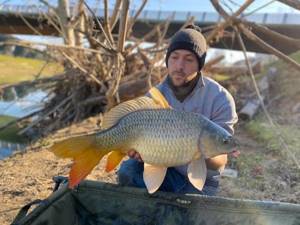
It is within the specified time frame that a large amount of fish can be caught, and a trophy specimen is often caught.
Structure of fish
To eliminate discrepancies and eliminate intrigue, I would initially like to note that both bream and bream are the same species of fish, at different stages of their physiological development. If bream are formed and sexually mature representatives of the genus, then bream are teenagers, gaining mass on the way to transition to a full-fledged fish individual. Breams are a species of peaceful carp fish. A distinctive feature of the body shape of one or the other age group is a rounded, laterally flattened body, with a high hump on the back, which becomes more distinct as the fish matures.
The height at the base of the dorsal fin of bream is proportional to their length and is approximately one third of its size. The fish, regardless of age, is covered with small scales compared to its carp counterparts, which during its life cycle changes color from silver to bronze and golden. The scales are covered with a layer of mucus, which is clearly visible when fishing, always dirtying the fisherman even when taking the most careful precautions. In relation to the body, this representative of cyprinids has a small head, with a specific tube mouth, adapted for collecting food from the bottom of reservoirs.
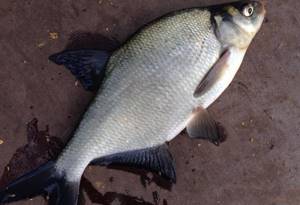
Bream
Among the plumage, the anal fin is distinguished by its size, which stretches in length from the lower abdomen almost to the very tail of the fish. The remaining fins do not stand out for the grandeur of their size, varying in color from gray to distinctly black tones. Fish is not an intensively growing species. It can live up to 20 years, although in natural conditions it most often does not live more than a dozen years. The fish grows up to half a meter in length and weighs six kilograms, but even two-kilogram individuals are considered quite serious trophy specimens.
What do they catch?
Bream is considered a peaceful fish species and is caught with different types of gear. The most successful are:
- float tackle;
- feeder tackle.
In open water from a boat, ring fishing will bring success; this method only works when catching bream.
All types of fishing and the correct equipment can be found and studied in more detail in other articles on our website. Thanks to the advice and recommendations of experienced fishermen, even a beginner will be able to independently assemble any gear and subsequently catch fish in any of the reservoirs.
Lifestyle
The differences between bream and bream in their lifestyle are small. These different age groups of the bream population are clearly schooling fish that migrate across the reservoir in search of food in huge schools, sometimes numbering thousands of individuals. Despite large schools, bream are considered to be quite cautious and shy fish. Any suspicious changes in water bodies, which are often a direct consequence of human activity, which includes construction and reclamation work, force bream schools to leave their usual habitats and never return to these uncomfortable water areas. Flocks feed along channel edges, at the borders where clear water adjoins thickets, and also like to comb the smooth slopes from the shallows into the deep zones.

Podleschik
Young breams stick to depths of up to five meters. Seasoned bream live at depths of several tens of meters. In terms of their lifestyle, some flocks are sedentary, which is more related to lake populations, inhabiting permanent areas of the reservoir, alternately combing their areas in search of food. River shoals, for the most part, are in constant migration, moving along the deepest trajectories of the channel, stopping briefly in the areas adjacent to them that are richer in food. In winter, flocks fall into wintering pits, greatly losing activity and falling into suspended animation, clinging tightly to each other and thus enduring the hardships of the cold period.
The main differences in fishing for bream and bream
Both age groups of bream can be caught in the same way, the only difference being the reliability of the gear and equipment due to the difference in the weight of the trophy. Among the general principles of fishing, it is worth noting the delicacy of the rigs, since careful fish do not allow the use of rough rigs, ignoring thick leashes and elements with glimpses and unnatural colors, which applies to a greater extent to hooks and feeders. Fishing with bottom gear, in particular feeder, and float rods is popular.
Less known and used in practice is fishing using spinning equipment. White bream can be caught in the shallows, which cannot be said about full-fledged bream, which must be hunted initially by selecting deep-sea areas. If the bream is caught with bait, then the bream need to be attached to the fishing site, setting baits a couple of days before the start of fishing. Complementary foods for small individuals do not require the inclusion of animal elements, the components of which, chopped worms and bloodworms, are required for catching bream. Mandatory ingredients for large specimens of fish are boiled porridge, millet and oatmeal. For small items, ground crackers mixed with store-bought mixtures are sufficient.
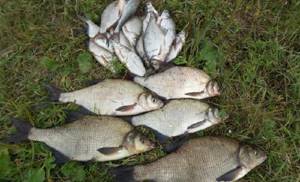
The most suitable attractants are sweet aromas, vanilla, cinnamon, honey, which are loved by fish of different ages. When installing bait on a trophy catch, its dimensions are increased. Catching white bream does not require large baits, and a panicle of 5–7 bloodworms can be considered an ideal working bait. Bream fishing requires careful elaboration of the strategy, advance bait and a couple of days long fishing session. Hunting for bream is quite similar to planning strategies for white fish like roach and silver bream. By following these simple tips from the article, the angler will not only be able to figure out the correct fishing names for this fish, but he will also certainly be able to get a trophy with the size and color of the scales, allowing him to say that a real bream was caught.
